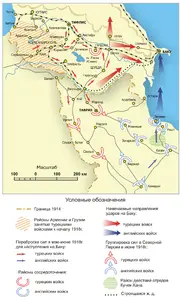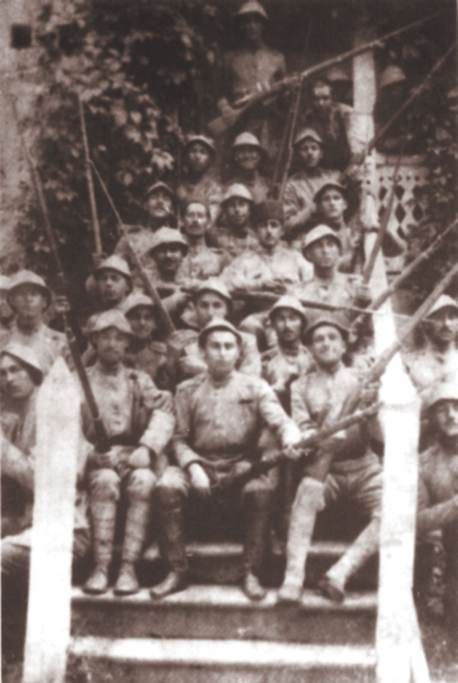-Ermeni-Azeri Savaşı 1917`de Ekim Devrimi yani Bolşevik Devrimi`nden sonra başlamıştır.Demokratik Ermenistan Cumhuriyeti kurulduktan sonra Azeri toprakları üzerinde hak iddiaa eden Ermeniler 1917-1922 arasında Azerilere saldırdılar.Çoğu saldırı düzenli ordu biçiminde olmadı.Bu saldırılar genellikle Azeri köylerinin basılıp Azerilerin katliama uğraması ile bitti.Böylece köyler boşalıyordu ve yok oluyordu.Sonuçta topraklar Büyük Ermenistan hayallerine bırakıyordu.Daha sonra Demokratik Azerbaycan Cumhuriyeti kuruldu.Osmanlı İmparatorluğu`nun Erivan`ı boşaltıp Iğdır Ovası`na çekilmesi Ermenileri ayaklandırdı ve savaş başlamış oldu.(1920)Ermeniler savaş genelinde gerilla taktiği uyguladı.Yani vurup kaçtılar.Böylelikle Ermeniler topraklarını genişletirken Azerileride katlediyorlardı.Ama savaşın gerçek nedeni daha da eskilere dayanıyordu.
-Bu savaşın nedeni Ermenilerin Azerbaycan ile Nahcivan arasındaki sınırı kesip Nahcivan`ı almak istemeleriydi.Bu projeyi tam olarak gerçekleştiremediler.Nahcivan ile Azerbaycan arasını aldılar ve şimdiki topraklarına kattılar.
Çatışmaların Genel Sonucu
-1905`te Bakü`de hem Ermeniler hemde Azeriler bulunuyordu.Ancak şehirde mahalle savaşları yaşandı şehir Azeriler ve Ermeniler olarak ikiye bölündü.Ancak Azerbaycan`ın eski Türk Yurdu olduğu gerçeğine karşı çıkamayan Ermeniler Bakü`yü boşalttı ve şimdiki Ermenistan sınırlarının içerisine sığındılar.Çatışmalar
-Bu savaş aynı zamanda Sovyet Rusya`sının iki tarafada gizli desteği ile başladı.Böylece iki tarafta yıpranacaktı ve Sovyetlerin genişleme politikası gereğince Sovyet topraklarına katılacaktı.Nitekim daha sonra Sovyet Sosyalist Azerbaycan ve Ermenistan olarak yıpranarak Sovyetler Birliği güdümüne girdiler.Rusların şehre 1920`de girmesi ile Bakülülerde Anti-Sovyet düşüncesi oluştu.Sovyetlere karşı bu düşünce tarzının benimsenmesinde Azeri kumandan General Talyshinski`nin tutuklanmasıydı.-1918`de Bakü`deki Bolşevik hareketleri sonucunda Victor Serge tarafından Bolşevik İhtilali`nin 1.yılı kutlandı.Buna karşı olan Azeriler zaten anti-sovyet düşüncesine sahip olunca gizlice örgütlendiler.Sonuçta inşaat işçilerinin ve liman işçilerinin bolşevik olması sonucu çoğunluğu sağlayan Sosyalist Azeriler sonuçta sosyalizmi azerilere kabul ettirdi.
1918-1919 Bakü ve Karabağ için yapılan Savaş
Seealso|Battle of Baku|September Days|Republic of Mountainous Armenia At the same time the Baku Commune was involved in heavy fighting with the advancing Caucasian Ottoman Army in and around Ganja. Enver Pasha, the Ottoman Empire, began to move forward with the newly established Army of Islam. Major battles occurred in Yevlakh and Agdash, where the Turks routed and defeated Dashnak and Russian forces.Dunsterville ordered the evacuation of the city on September 14, after six weeks of occupation, and withdrew to Iran; most of the Armenian population escaped with British forces. The Ottoman Army of Islam and its Azeri allies, led by Nuri Pasha, entered Baku on September 15 and slaughtered between 10,000 - 20,000 Armenians in retaliation for the March massacre of Muslims. Croissant. ``Armenia-Azerbaijan Conflict``, p. 15. The capital of the Azerbaijan was finally moved from Ganja to Baku. However, after the Armistice of Mudros between the United Kingdom and the Ottoman Empire on October 30, Turkish troops were substituted by the Triple Entente. Headed by British general W. Thomson, who had declared himself the military governor of Baku, 5,000 Commonwealth soldiers arrived in Baku on November 17, 1918. By General Thomson`s order, martial law was implemented in Baku.
The Armenian government tried several times to seize Shusha militarily. Beginning with 1918, Republic of Mountainous Armenia was declared in the region. However throughout the summer of 1918, Armenians in the mountainous Karabag region, under the leadership of Andranik Toros Ozanian resisted the Ottoman 3th armyMark Malkasian, Gha-Ra-Bagh": the emergence of the national democratic movement in Armenia page 22. In August, they set up an independent government in Shushi, the administrative center of the region. The conflict was fierce, but indecisive. The Armenian militia under Adriancik`s command decimated an Ottoman unit trying to advance to the Varanda River. The armed conflicts between these units continued until the Armistice of Mudros. After the Armistice, the Ottoman Empire began to withdraw its forces and Armenian forces under Andranik seized Nagro-KarabaghHafeez Malik "Central Asia: Its Strategic Importance and Future Prospects" page 145. Armstice of Mudros brought General Adriank the chance to create a base for further expansion eastward and form a strategic corridor extending into Nakhichevan. In January 1919 Armenian troops advanced towards Shusha, captured and destroyed 9 Azeri villages on their way but eventually had to retreat. Just before the Armistice of Mudros was signed, Andranik was on the way from Zangezur to Shusha, to control the main city of the Karabakh. The Armenian government tried several times to seize Shusha militarily, before. In January 1919, while Armenian troops advancing, the Dunsterforce ordered Andranik back to Zangezur, and gave him the assurances that this conflict can be solved with the Paris Peace Conference, 1919. Andranik pulled back his units and British command at Baku gave the control to the Dr. Khosrov Bek Sultanov. Khosrov bey Sultanov, a native of Karabakh was appointed the general-governor of Karabakh. He had three Armenian and three Azeri aides.
Fight for Karabakh, early 1920
The largest Armenian-Azeri ethnic clashes in Shusha took place on March-April 1920. On the night from March 21-22, 1920 when the Azeris were celebrating Spring Equinox (Novruz Bayram), the Armenians of Karabakh began to revolt and organized a surprise attack.They seized the approaches to Shusha, Khankendi, and the Askeran fortress, attacking the Azeri part of the town and burned the houses on their wayFact|date=September 2007.
On March 22-26, 1920, the massacres of Shusha Armenians"The British administrator of Karabakh Colonel Chatelword did not prevent the discrimination of Armenians by the Tatar administration of Governor Saltanov. The ethnic clashes ended with the terrible massacres in which the most of Armenians in Shusha town perished. The Parliament in Baku refused to even condemn those responsible of the massacres in Shusha and the war started in Karabakh. A. Zubov (in Russian) Ğ.Зубов ПолитичеÑкое будущее Кавказа: опыт ретроÑпективно-Ñравнительного анализа, журнал "ЗнамьÑ", 2000, #4, http://magazines.russ.ru/znamia/2000/4/zubov.html"massacre of the Armenians of Nagorno-Karabakh`s capital, Shushi (called Shusha by the Azerbaijanis)", Kalli Raptis, "Nagorno-Karabakh and the Eurasian Transport Corridor", http://72.14.235.104/search?q=cache:MSbXaimmyAcJ:www.eliamep.gr/eliamep/files/op9803.PDF"A month ago after the massacres of Shushi, in April 19, 1920, prime-ministers of England, France and Italy with participation of the representatives of Japan and USA collected in San-Remo..." Giovanni Guaita (in Russian) Джованни Ğ“Ğ£ĞЙТĞ, ĞÑ€Ğ¼ĞµĞ½Ğ¸Ñ Ğ¼ĞµĞ¶Ğ´Ñƒ кемалиÑÑ‚Ñким молотом и большевиÑÑ‚Ñкой наковальней // «ГРĞĞ–Ğ”ĞĞИĞ», M., # 4, 2004 http://www.grazhdanin.com/grazhdanin.phtml?var=Vipuski/2004/4/statya17&number=%B94 Armenia in Crisis: The 1988 Earthquake - Page 6 by Pierre Verluise took place, which resulted many Armenian deaths and the destruction of the Armenian quarter of the city.
The fighting increased in intensity by February 1920 and martial law was introduced in Karabakh, which was enforced by the newly formed National Army, led by general Samedbey Mehmandarov.
Sovietization of Azerbaijan, April 1920
In early April 1920 the Republic of Azerbaijan was in a very troubled situation. In the west, the Armenians still occupied large parts of Azeri territory; in the east, the local Azeri communists were rebelling against the government; and to the north the Russian Red Army was steadily moving southward, having defeated Denikin`s White Russian forces.On April 27, 1920 the government of the Azerbaijan Democratic Republic received notice that the Soviet army was about to cross the northern border and invade the ADR. Faced with such a difficult situation, the government officially surrendered to the Soviets, but many generals and local Azeri militias kept resisting the advance of Soviet forces and it took a while for the Soviets to stabilize the newly-proclaimed Azerbaijan Soviet Socialist Republic, headed by the leading Azeri Bolshevik Nariman Narimanov.
While the Azeri government and army were in chaos, the Armenian army and local Armenian militias used the opportunity to assert their control over parts of Azeri territory, taking Shusha, Khankendi, and other important cities. By the end of April the Armenian forces were in control of most of western Azerbaijan including all of Karabakh with the surrounding areas. Other area captured included all of Nakhichevan and much of Kazakh-Shamshadin district. In the meantime, the Armenian communists attempted a coup in Armenia, but ultimately failed.
Azeri and Soviet counter-attack, May 1920
After having gained firm control of Azerbaijan, the Soviet forces moved on to reclaim the Armenian-occupied areas in the west for the Azerbaijan SSR. The Azeri army was reorganized along Soviet lines and reequipped with Russian weapons.The Russian and Azeri offensive started in early June and resulted in quick defeat of Armenian forces. On June 5 the Armenian forces were expelled from Shusha. In early July Armenians withdrew from Tatev and suffered several defeats in Kazakh-Shamshadin area. On 28 July the Soviet forces and their Turkish allies staged an assault on Nakhichevan City, expelling Armenian forces and establishing a joint Russian/Azeri/Turkish occupation of the province. In early August, Armenian troops made one more attempt to take over Nakhichevan but were defeated at Shakh-Takhty by joint Soviet-Turkish corps. Thus, the Azerbaijan SSR was fully restored to the borders of Azerbaijan Democratic Republic prior to Armenian invasion.
On August 10 1920, the cease-fire agreement was signed in Yerevan between Soviet and Armenian forces, ending the hostilities and forcing Armenia to recognize the Azeri control of Karabakh and temporary independence of Nakhichevan. Sporadic fighting continued in Karabakh district where several Armenian warlords refused to stop guerilla war.
End of hostilities, September-November 1920
Seealso|Turkish-Armenian War|Treaty of Alexandropol In September 1920 Armenia was engaged in a bitter war on another front against Turkish Revolutionaries. The Turkish-Armenian war of September-November 1920 stripped Armenia of most of its south-western territories, including Kars and Alexandropol, severely exhausted the military capacity of Armenian army, and left Armenia broken and abandoned. However, the Turkish forces were unable to completely defeat Armenia and after their defeat near Yerevan, Turkey signed a cease-fire.In late November, there was yet another Soviet-backed communist uprising in Armenia. On November 28, 1920 blaming Armenia for the invasions of Sharur (20.11.1920) and Karabakh (21.11.1920), the 11th Red Army under the command of Anatoli Gekker, crossed the demarcation line between Democratic Republic of Armenia and Soviet Azerbaijan. The second Soviet-Armenian war lasted only a week.
Aftermath
The Armenian national liberation movement was exhausted by the 6 years of permanent wars and conflicts; the Armenian army and population were incapable of any further active resistance.Sovietization of Armenia, December 1920
Seealso|Democratic Republic of Armenia|Turkish-Armenian WarOn December 4 1920, when the Red Army entered Yerevan, the government of the Democratic Republic of Armenia effectively surrendered. On December 5, the Armenian Revolutionary Committee (Revkom; made up of mostly Armenians from Azerbaijan) also entered the city. Finally, on the following day, December 6, Felix Dzerzhinsky`s dreaded secret police, the Cheka, entered Yerevan, thus effectively ending all existence of the Democratic Republic of Armenia. Robert H. Hewsen. ``Armenia: A Historical Atlas``, p. 237. ISBN 0-226-33228-4
The Armenian Soviet Socialist Republic was then proclaimed, under the leadership of Aleksandr Miasnikyan.
Treaty of Kars, 23 October 1921
Main|Treaty of Kars The violence in Transcaucasia was finally settled in a friendship treaty between Turkey and the Soviet Union. The peace Treaty of Kars was signed in Kars by representatives of the Russian SFSR, Azerbaijan SSR, Armenian SSR, Georgian SSR, and Turkey. Turkey had another agreement, the "Treaty on Friendship and Brotherhood", also called the Treaty of Moscow, signed on March 16, 1921 with Soviet Russia.By this treaty Nakhichevan was granted the status of an autonomous region within Azerbaijan. Turkey and Russia became guarantors of Nakhichevan`s status. Turkey agreed to return Alexandropol to Armenia and Batumi to Georgia.
Notes
ReflistBibliography
- http://hrw.org/reports/1995/communal
See also
- Azerbaijan Democratic Republic
- Democratic Republic of Armenia
- History of Nagorno-Karabakh
- Turkish-Armenian War
External links
- Armenian- Azerbaijani War of 1919 - 1920 (In Russian)
- Soviet-Armenian War and the Collapse of the First Republic: November-December, 1920
Wars involving Armenia Wars involving Azerbaijan Wars involving the Ottoman Empire Nagorno-Karabakh History of Azerbaijan Russian Revolution 20th century in Armenia

